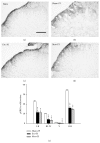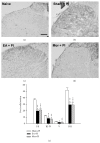Comparison of electroacupuncture and morphine-mediated analgesic patterns in a plantar incision-induced pain model
- PMID: 25530786
- PMCID: PMC4233674
- DOI: 10.1155/2014/659343
Comparison of electroacupuncture and morphine-mediated analgesic patterns in a plantar incision-induced pain model
Abstract
Electroacupuncture (EA) is a complementary therapy to improve morphine analgesia for postoperative pain, but underlying mechanism is not well-known. Herein, we investigated EA-induced analgesic effect in a plantar incision (PI) model in male Sprague-Dawley rats. PI was performed at the left hind paw. EA of 4 Hz and high intensity or sham needling was conducted at right ST36 prior to PI and repeated for another 2 days. Behavioral responses to mechanical and thermal stimuli, spinal phospho-ERK, and Fos expression were all analyzed. In additional groups, naloxone and morphine were administered to elucidate involvement of opioid receptors and for comparison with EA. EA pretreatment significantly reduced post-PI tactile allodynia for over 1 day; repeated treatments maintained analgesic effect. Intraperitoneal naloxone could reverse EA analgesia. Low-dose subcutaneous morphine (1 mg/kg) had stronger inhibitory effect on PI-induced allodynia than EA for 1 h. However, analgesic tolerance appeared after repeated morphine injections. Both EA and morphine could equally inhibit PI-induced p-ERK and Fos inductions. We conclude that though EA and morphine attenuate postincision pain through opioid receptor activations, daily EA treatments result in analgesic accumulation whereas daily morphine injections develop analgesic tolerance. Discrepant pathways and mechanisms underlying two analgesic means may account for the results.
Figures





Similar articles
-
Spinal p38 activity and analgesic effect after low- and high-intensity electroacupuncture stimulation in a plantar incision rat model.Life Sci. 2015 May 1;128:15-23. doi: 10.1016/j.lfs.2015.01.035. Epub 2015 Mar 2. Life Sci. 2015. PMID: 25744405
-
Alleviating Mechanical Allodynia and Modulating Cellular Immunity Contribute to Electroacupuncture's Dual Effect on Bone Cancer Pain.Integr Cancer Ther. 2018 Jun;17(2):401-410. doi: 10.1177/1534735417728335. Epub 2017 Sep 4. Integr Cancer Ther. 2018. PMID: 28870114 Free PMC article.
-
[Bone-edge electroacupuncture relieves pain by regulating expression of GRK5, β-arrestin 2 and PKCα proteins in locus coeruleus in bone cancer pain rats with morphine tolerance].Zhen Ci Yan Jiu. 2020 Feb 25;45(2):87-92. doi: 10.13702/j.1000-0607.1900036. Zhen Ci Yan Jiu. 2020. PMID: 32144916 Chinese.
-
Activation of spinal anti-analgesic system following electroacupuncture stimulation in rats.J Pharmacol Sci. 2005 Dec;99(4):408-14. doi: 10.1254/jphs.fp0050502. Epub 2005 Dec 7. J Pharmacol Sci. 2005. PMID: 16340154
-
The Involvement of Descending Pain Inhibitory System in Electroacupuncture-Induced Analgesia.Front Integr Neurosci. 2019 Aug 21;13:38. doi: 10.3389/fnint.2019.00038. eCollection 2019. Front Integr Neurosci. 2019. PMID: 31496944 Free PMC article. Review.
Cited by
-
Laser acupuncture-induced analgesic effect and molecular alterations in an incision pain model: a comparison with electroacupuncture-induced effects.Lasers Med Sci. 2018 Feb;33(2):295-304. doi: 10.1007/s10103-017-2367-7. Epub 2017 Nov 4. Lasers Med Sci. 2018. PMID: 29103083 Free PMC article.
-
Electroacupuncture in conscious free-moving mice reduces pain by ameliorating peripheral and central nociceptive mechanisms.Sci Rep. 2016 Sep 30;6:34493. doi: 10.1038/srep34493. Sci Rep. 2016. PMID: 27687125 Free PMC article.
-
Electroacupuncture Attenuates Cerebral Ischemia and Reperfusion Injury in Middle Cerebral Artery Occlusion of Rat via Modulation of Apoptosis, Inflammation, Oxidative Stress, and Excitotoxicity.Evid Based Complement Alternat Med. 2016;2016:9438650. doi: 10.1155/2016/9438650. Epub 2016 Mar 31. Evid Based Complement Alternat Med. 2016. PMID: 27123035 Free PMC article.
-
Intraoperative electroacupuncture relieves remifentanil-induced postoperative hyperalgesia via inhibiting spinal glial activation in rats.Mol Pain. 2017 Jan-Dec;13:1744806917725636. doi: 10.1177/1744806917725636. Mol Pain. 2017. PMID: 28825338 Free PMC article.
-
Electroacupuncture Inhibits the Activation of p38MAPK in the Central Descending Facilitatory Pathway in Rats with Inflammatory Pain.Evid Based Complement Alternat Med. 2017;2017:7531060. doi: 10.1155/2017/7531060. Epub 2017 Nov 22. Evid Based Complement Alternat Med. 2017. PMID: 29358970 Free PMC article.
References
-
- Buvanendran A., Kroin J. S., Tuman K. J., et al. Effects of perioperative administration of a selective cyclooxygenase 2 inhibitor on pain management and recovery of function after knee replacement: a randomized controlled trial. The Journal of the American Medical Association. 2003;290(18):2411–2418. doi: 10.1001/jama.290.18.2411. - DOI - PubMed
-
- Remérand F., Le Tendre C., Baud A., Couvret C., Pourrat X., Favard L., Laffon M., Fusciardi J. The early and delayed analgesic effects of ketamine after total hip arthroplasty: a prospective, randomized, controlled, double-blind study. Anesthesia and Analgesia. 2009;109(6):1963–1971. doi: 10.1213/ANE.0b013e3181bdc8a0. - DOI - PubMed
LinkOut - more resources
Full Text Sources
Other Literature Sources
Research Materials
Miscellaneous

